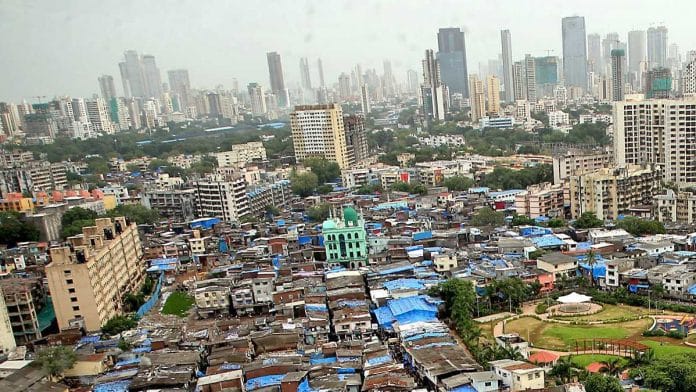New Delhi: Indian cities lack basic urban planning frameworks despite fast-paced urbanisation, according to the Annual Survey of India’s City-System (ASICS) 2023 conducted by Janaagraha, a Bengaluru-based think tank.
The report, released Tuesday by Union housing and urban affairs minister Hardeep Singh Puri, reveals that 39 percent of India’s capital cities lack an active master plan. And only nine cities have prepared sectoral plans for key aspects such as sanitation, comprehensive mobility, and sustainability.
In terms of urban governance, 15 states employ a common municipal legislation for all their cities, regardless of varying population density and size, the report adds.
Poor urban planning and weak city governance are responsible for issues such as waterlogging, flooding, air pollution, garbage crises, and traffic congestion in Indian cities, the report notes, pointing out the urgent need to fix the “root-causes that lie within city-system”.
The report, the sixth edition of ASICS, also evaluates the quality of urban laws of 35 states and Union territories, including Municipal Acts and Town and Country Planning Acts. Only Lakshadweep has not been included as it doesn’t have a statutory town and a municipal legislation.
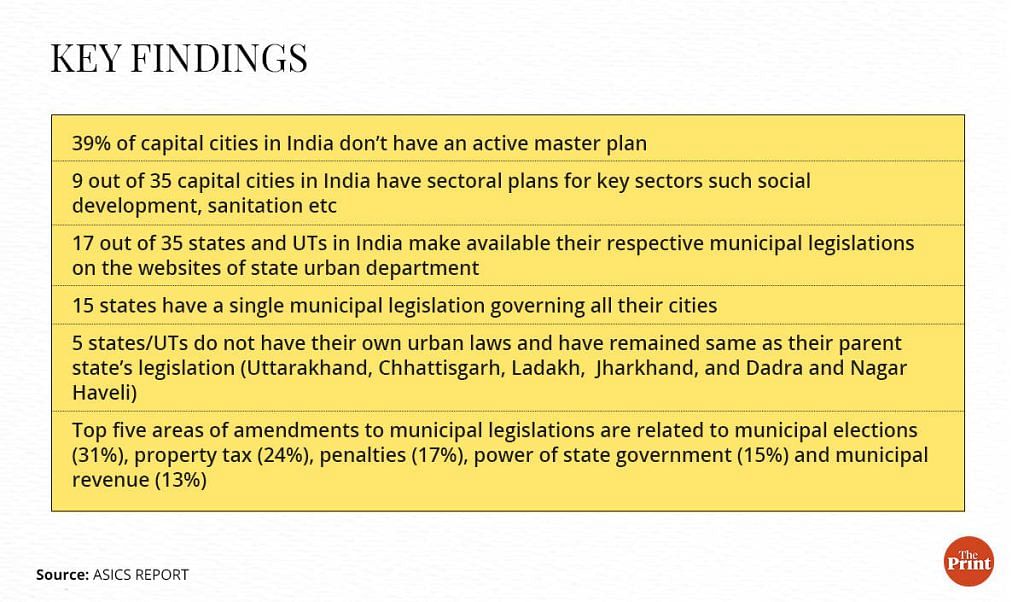
It stresses upgrading municipal laws and empowering local urban bodies by ensuring devolution of powers in line with the Constitution’s 74th Amendment Act of 1992.
“We have evaluated the quality and implementation of urban laws that govern the Indian cities. While there has been a lot of investment in urban infrastructure in cities in the past 8-9 years, there has been no reform in the city system,” Srikanth Viswanathan, chief executive officer of Janaagraha, told ThePrint.
He added that any gains made in the short term have to be sustained with systemic reforms.
“There is an urgent need for integrated and holistic development of cities. It is important that the state governments take measures to empower city governments, as municipal legislations are a state subject,” he said.
At the launch, Union minister Puri said that the fact that this report included the study of 82 municipal legislations and 44 Town and Country Planning Acts and allied laws, rules, and regulations was “praiseworthy”.
“The recommendations made in the report can deepen the principles of decentralisation and devolution in urban governance and revitalise the spirit of the 74th Constitutional Amendment,” Puri added.
The report pinpoints four essential areas for reform in city-systems. The first is urban planning and design, which includes spatial planning, land use, and the design of public spaces. The second is urban capacities and resources, encompassing finance, staffing, performance management, and digitalisation in city governments, and the third is empowered and legitimate political representation in the form of mayors and city councils. Lastly, the framework underscores transparency, accountability, and participation, pertaining to the involvement of citizens in neighbourhood-level governance.
The report says India’s urbanisation level, according to the 2011 Census, stands at 31.1 percent, with 181 districts out of 640 exceeding the national average. In states such as Bihar, Chhattisgarh, Odisha, and Uttar Pradesh, 72 districts have an urbanisation rate higher than the state average. These factors make urban planning and design crucial for sustainable urban development.
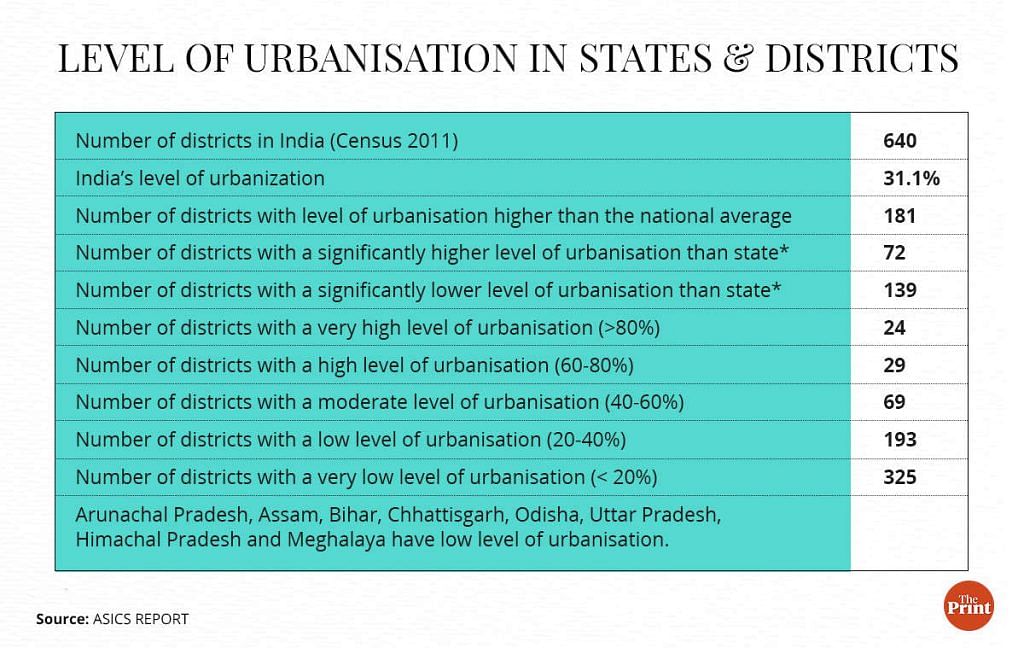
“India’s cities are burgeoning,” the report underscores, citing the 2014 revision of the World Urbanisation Prospects by the Population Division of the Department of Economic and Social Affairs at the United Nations. “Our cities are expected to host over 800 million citizens by 2050, over half of India’s population.”
Also Read: India’s rapid global growth rate is not translating to quality of life in its cities
Lack of a game plan & heavy costs
Last year, unprecedented rains in Bengaluru left large parts of the city under water for nearly two days, causing huge loss to property and bringing the city to a standstill.
Similarly, in July this year, the national capital, Delhi, faced a comparable crisis. Parts of the city, including Rajghat and areas around the Red Fort, were inundated as the Yamuna River exceeded its 45-year-old highest flood level of 207.49 metres due to heavy rains and the release of a large volume of water from the Hathnikund Barrage.
These incidents highlight the serious challenges that cities are confronting today, from flooding to traffic congestion and air pollution.
However, addressing these issues is hindered by the fact that many cities lack a master plan or a vision document.
The report reveals that out of India’s 33 capital cities, 13 have “inactive master plans” or plans that have lapsed without replacement.
Robust plan preparation is essential for improving the quality of infrastructure and services for residents and avoiding urban sprawl, the report said.
But just seven states — Andhra Pradesh, Bihar, Delhi, Haryana, Jharkhand, Telangana (Hyderabad) — and Uttar Pradesh mandate the “creation of three levels of Spatial Development Plan”, or SDPs, at the regional, municipal, and ward levels, the report says.
“No state in India provides an effective system to prevent the approval of projects that are not in conformity with the SDPs. Additionally, there are no robust provisions by law to monitor ongoing projects for possible violations. States also have very weak provisions to penalise plan violations,” the report states.
In 23 out of 35 states and Union territories, the TCP Acts have established penalties for just one type of violation, specifically, obstructing work or the entry of contractors, according to the report. Conversely, only four states—Chhattisgarh, Haryana, Maharashtra, and Telangana—have regulations in place to penalise substantive violations, such as changes in building use.
Saswat Bandyopadhyay, an Ahmedabad-based urban planner, told ThePrint that the laws governing development in cities need to be revised.
“The present Acts and regulations are very old and have little relevance in the present day and age. When these Acts were framed, there was hardly any urbanisation in the country. The current urban planning regime in India bears the imprint of its colonial past,” he said.
Bandyopadhyay added that laws are not designed to prepare cities for climate shocks. He also noted that the development of cities was hindered by the “multiplicity of authorities” involved.
Urban development experts also blame poor implementation of existing plans for ongoing issues in cities.
For instance, the draft Master Plan of Delhi-2041, aimed at making the national capital a “24-hour city”, has been pending for three years. Similarly, the new master plan for Bengaluru is yet to be notified.
“Whether it is Bengaluru, Delhi, or any other Indian city, the biggest problem is delay in implementation of master plans or the absence of them,” said N Sridharan, former director of the School of Planning and Architecture in Bhopal.
“In most cases, the water bodies and the natural drainage systems have been encroached upon and buildings have come up. This unplanned development is the root-cause of the problems we faced today,” he added.
Giving more powers to cities
While government spending on urban development has increased dramatically in the past decade, this has not led to the necessary systemic reforms, according to the report.
It highlights that the budget outlay of the Ministry of Housing and Urban Affairs (MoHUA) increased from approximately Rs 8,000 crore in 2009-10 to Rs 47,000 crores in 2021-22, an increase of 488 percent. However, this has not led to progress on “city-systems reforms” commensurate with the pace of urbanisation and progress made on outlays for urban development projects.
To address this, the report stresses the need to empower city governments or municipal corporations by implementing the 74th Constitutional Amendment Act (CAA) of 1992, which came into force on 1 June 1993.
This Act had a list of 18 critical functions for the state governments to transfer to urban local bodies (ULBs). These functions include urban planning, water supply, fire, and land use regulations, slum improvement, among others.
But according to the report, on average, only 42 percent of the 74th CAA has been implemented by states.
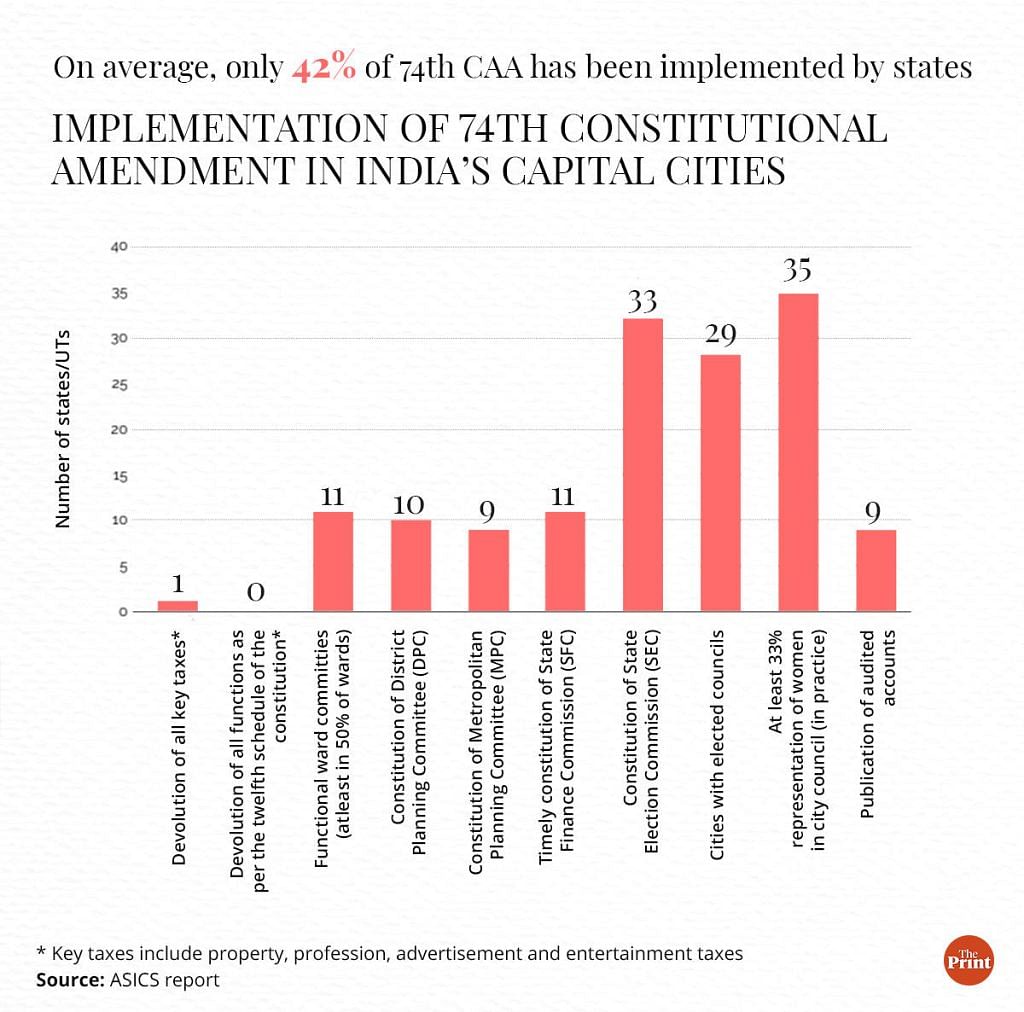
“Empowered city governments would be a key force in driving local action for global challenges such as climate change, public health including water and sanitation, affordable housing, and gender equity. There is a need to urgently review the effectiveness of 74th CAA and make it fit for purpose,” the report says.
This is not the only gap as far as laws are concerned— legislations governing city governments are a problem area too.
According to the report, there are 82 municipal legislations across 35 states and UTs.
Of these, 15 states have a single municipal legislation governing all their cities. Further, five states and UTs do not have their own urban laws, and the parent state’s legislation applies to them.
“Uttarakhand, Chhattisgarh, and Ladakh have not created their own distinct municipal and town and country planning acts and have chosen to continue with the legacy of the erstwhile undivided states they were a part of. Similarly, Jharkhand, Dadra and Nagar Haveli, have not updated their town and country planning acts,” the report said.
An analysis of municipal legislation by Janaagraha shows that some eastern states have relatively better urban legislations in terms of empowerment of mayors.
“Most of the eastern states (Bihar, Jharkhand, and Odisha) have directly elected mayors with all of them empowering their mayors with a tenure of five years,” the report says.
Another area of concern that the report emphasises is transparency in financial and operational information. Lack of this, it says, hinders “constructive engagement of citizens, civil society, and the media”.
Only 11 out of 35 states — Assam, Jharkhand, Karnataka, Madhya Pradesh, Maharashtra, Odisha, Punjab, Sikkim, Telangana, and Tamil Nadu — have embraced an open data policy that extends to city governments, the survey found.
“Our analysis across the 35 capital cities found that the only data available in open data format was civic works data of Ranchi, Patna, Jammu and Thiruvananthapuram,” the report notes.
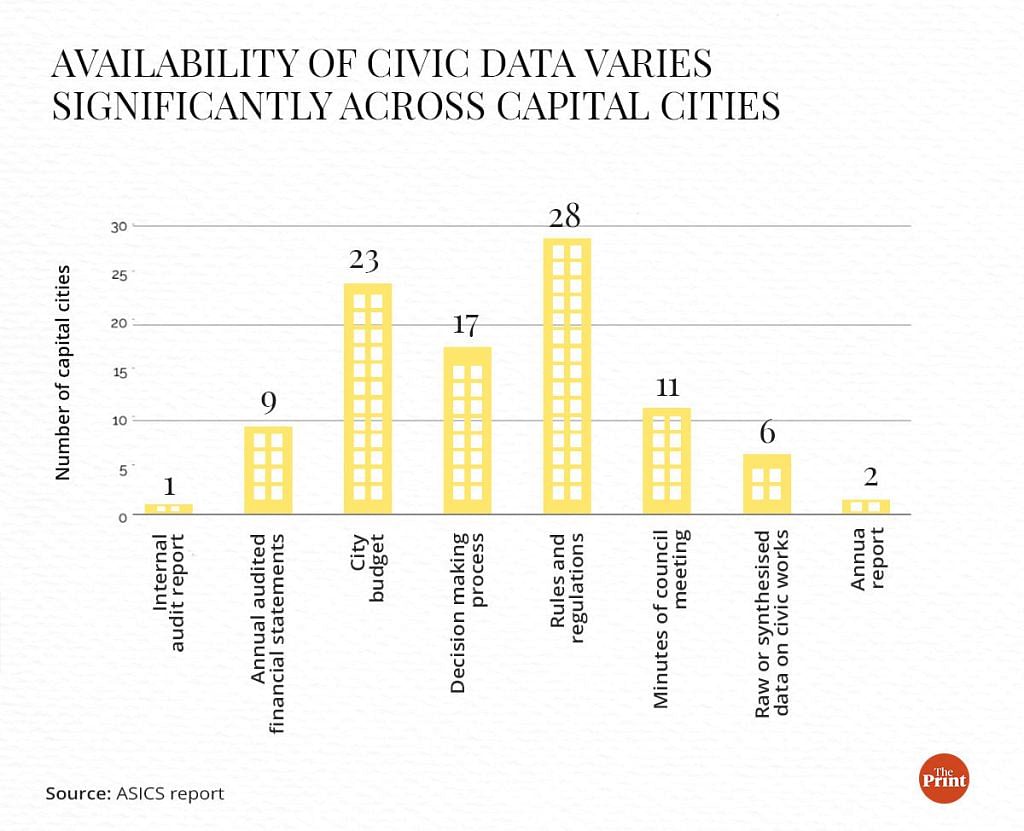
Janaagraha’s Vishwanathan told ThePrint that the think tank has recommended 10 models or “instruments of change” that can help fix the root causes of issues within the city system.
These encompass spatial development plans, standards for street and public space design, improved metropolitan governance, empowered mayors, and participatory budgeting, among others.
“If these 10 big changes are implemented, then it will bring out a change in our present system, which is essential for managing climate change in the future,” he said.
(Edited by Asavari Singh)



